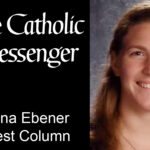By Patrick Schmadeke
A group recitation of the familiar prayer, the Glory be (Gloria Patri), caught my attention recently. In particular, the words “world without end” struck me as confusing, because we know that the world will end. In the next billion years the brightness of the sun will increase such that the oceans will evaporate. Billions of years later, the size of the sun will grow and engulf earth. So, why do we pray, “world without end”?
This naturally raised other questions: “do I mean the words that I pray? If so, in what way?” Here are concrete examples of the complexities behind two of our rote prayers.
The Our Father has been a beautiful and beloved prayer among Christians for nearly 2,000 years. But there are at least three considerations which make this prayer less than straightforward.
First, when we say that we pray the Our Father, what we mean is that we pray Matthew’s version of the Our Father. One scholar quipped that the number of people who know Luke’s version of the prayer could probably fit in a telephone booth! It is worth asking what differences exist between the two versions, but that’s another article.
Second, the Our Father is sometimes introduced by the phrase: “the words our Savior taught us.” In what way is this true? Jesus didn’t speak English, so the words that we pray were not taught to us by Jesus. Furthermore, while the day to day language Jesus spoke was Aramaic, the most ancient form of the Our Father that we have is written in the Greek New Testament.
Third, both Matthew and Luke’s form of the Our Father include the Greek word ἐπιούσιος (epiousios) (Matt 6:11, Luke 11:3). It is translated in English as “daily” in the phrase, “give us this day our daily bread.” The trouble is that this Greek word doesn’t appear anywhere else in ancient literature, so we don’t really know specifically what the word means. Even St. Jerome, the patron saint of translators, when translating the Bible into Latin, translated this word differently in the two instances it appears (this is also another article).
Similar complexities present themselves in the Gloria Patri. To begin with, there are two forms of the Gloria Patri. The first contains the confusing phrase “Glory be to the Father and to the Son and to the Holy Spirit, as it was in the beginning, is now, and ever shall be, world without end. Amen.” The second version of the prayer reads, “Glory to the Father and to the Son and to the Holy Spirit, as it was in the beginning, is now, and will be forever.”
As it turns out, the first of these is a Pre-Vatican II form of the prayer. Since Vatican II the church has been intentional in omitting the phrase “world without end,” and instead using the second form of the prayer in liturgical documents.
A second complexity is that there are both ancient Greek and Latin forms of the Gloria Patri. In the Greek version the phrase “world without end” is simply not there. I have it on the good authority of my classmate that this is also the case in the Latin version of the prayer.
I also came across an author who pointed out the rhythmic beauty of this prayer. We pray a three-part glory to the (1) Father, (2) Son and (3) Holy Spirit, which is echoed by the use of three tenses to express God’s eternal glory: was, is and will be. Additionally, it is interesting to note that at the Council of Vaison in 529 the explicit reference to God’s eternal nature in this prayer was used to respond to Arianism, which held the Son is not eternal (“there was a time when Christ was not.”)
The many prayers in our tradition, from the Gloria Patri to the Our Father, and the many styles of prayer, from rote to conversational, all have native strengths which benefit spirituality as well as potential downsides to navigate. It is worth reflecting on this in order to maintain a balanced prayer life.
(Editor’s note: Patrick Schmadeke is a graduate of St. Ambrose University (‘13) and a student in the Master of Divinity program at the University of Notre Dame. His column offers reflections on his coursework, engaging with the richness of the Catholic Tradition and its relevance to the world today.)











